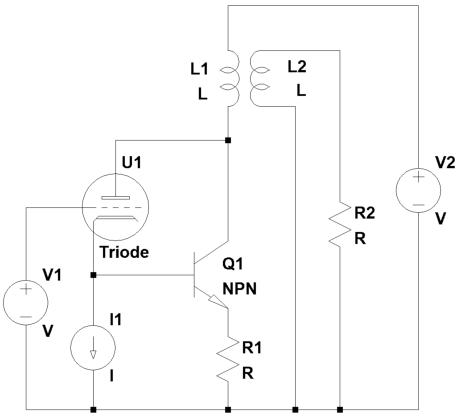Nashville SE 20 - Introduction
The voltage swing at the primary output transformer coils
is fed back into the plate. Triodes have an internal
negative feedback loop which is described by the Triode
Equation
R
a
(plate resistance) * g
m
(transconductance) = µ (gain).
Gain µ is given by the quotient from the output and the
input signal by
µ = - V
out
/ V
in
The minus sign indicates the 180° phase shift between
input and output signal. If the input signal is moving V
in
positive, the plate current increases and V
out
decreases
due to the increased voltage drop across the plate load. As
a consequence the decreased V
out
will try to reduce the
plate current. If the input signal is taking V
in
more negative
the plate current decreases and the rising V
out
will try to
increase plate current. V
in
and V
out
are pulling

Fig. 1: SuperTriode concept. From a simplified point
of view the circuit acts like a servo steering where the
tube (the driver) controls the signal and the transistor
(the servo) delivers the power.

The rating plates of my Newtronics Temperance speakers
recommend at least 20W into 4Ohm and thus rule out most
power triodes such as 2A3, 300B and even the legendary 6c33c
unless you are willing to parallel tubes which may generate
more problems than it solves. On the other hand in the absence
of strong global negative feedback harmonic spectra at large
audio signal amplitudes seem to be more favorable in tubes
rather than in solid state devices.
Figure 1 shows the basic concept of a tube / solid state hybrid SE amplifier which inspired me for my own project.
The circuit was published in the TubeCAD Journal articles “SuperTriodes” (2009) and „more SuperTriodes” (2015).
The triode works as a cathode follower driving a power solid state device (BJT or MosFet).
SE stands for Single-Ended, mostly referring to Single Ended power amplifiers. At first glance SE could also stand for
Small Efficiency, Super Expensive or may be even Stupid Engineering. However, even respected audio designers
seriously consider SE designs and evidently they have some basic advantages in managing the audio signal (Nelson
Pass, Peter Qvortrup, Pavel Macura, Andrea Ciuffoli and others). But is their real life performance really superior to
that of conventional push-pull designs? To find out it might be a good idea to just build one and listen.
in opposite directions and reduce the change in plate current inducing the specific internal negative feedback of a
triode. In conclusion the power triode controls the signal through local feedback while the transistor multiplies the
current by its given current gain and virtually makes the triode a SuperTriode.
super triode, vinyl, audio, analog, single ended, SE, power amplifier, hybrid, tube, KT66, 6SN7, ECC88, Mosfet, Lundahl, MC phono stage, preamplifier, MM, MC, moving coil, moving magnet, LL1693, LL1667, LL9226, LL1933, RIAA, folded
cascode, 2CS5200, MAT12, 2N3810, LL1660S, IXFN32N120P, balancing amplifier